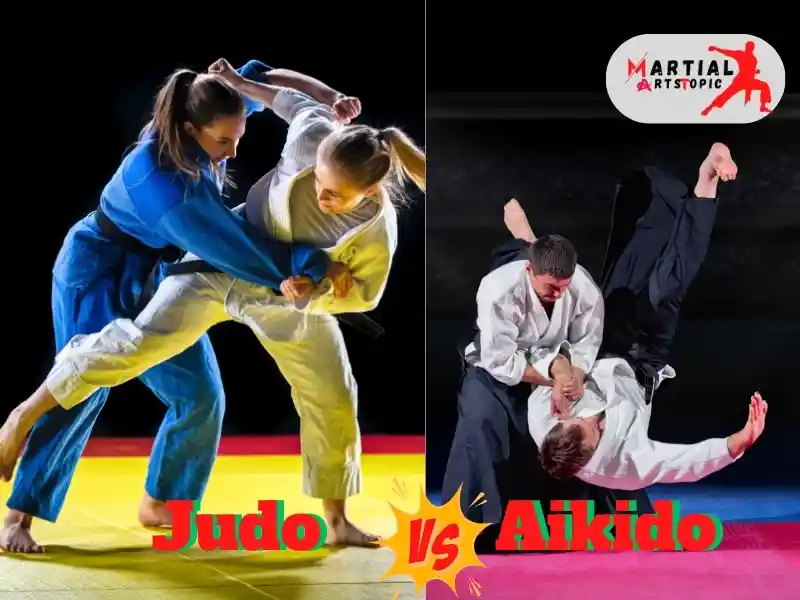
Judo vs Aikido: Which Martial Art Reigns Supreme?
When comparing Judo vs Aikido, it’s essential to understand that both martial arts have their strengths and unique qualities. Judo, known for its emphasis on throws and grappling techniques, is a powerful art that focuses on using an opponent’s energy against them. On the other hand, Aikido is a more fluid and harmonious practice, centered on redirecting an attacker’s force and using joint locks and throws. While Judo excels in close combat and ground fighting, Aikido emphasizes blending with an opponent’s movements and redirecting their energy. Ultimately, the question of which martial art reigns supreme between Judo vs Aikido comes down to personal preference, goals, and the individual’s aptitude for each art. Both Judo and Aikido offer valuable self-defense skills and physical conditioning, making them worthwhile pursuits for anyone interested in martial arts.
Judo vs Aikido: Unveiling the Differences and Similarities in these Dynamic Martial Arts
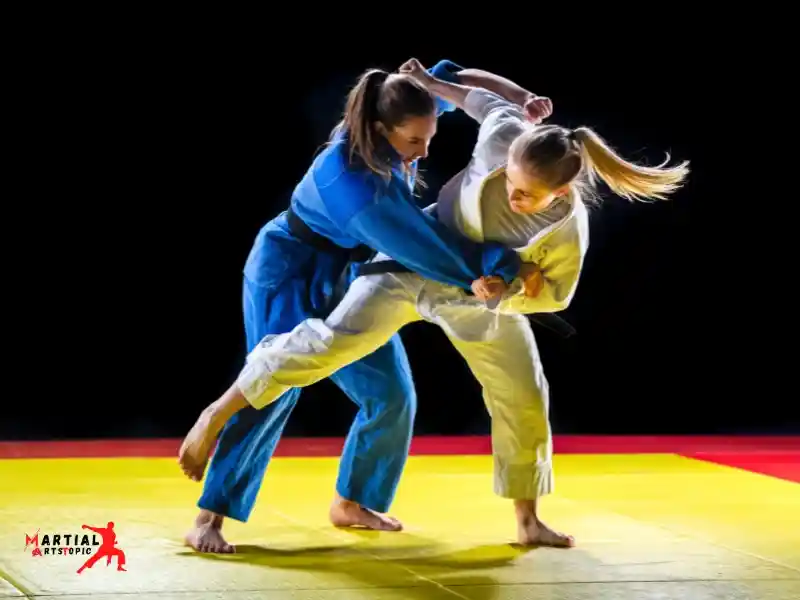
Judo and Aikido are two dynamic martial arts that have captivated the interest of practitioners and enthusiasts alike. Both disciplines boast rich histories, unique philosophies, and effective techniques. The differences and similarities between Judo and Aikido, shedding light on what sets these martial arts apart and what unites them in the world of combat sports.Judo, often referred to as the “gentle way,” is a Japanese martial art that focuses on grappling and throwing techniques. Founded by Jigoro Kano in the late 19th century, Judo places a strong emphasis on using an opponent’s energy and momentum against them. It is renowned for its competitive aspect, with international tournaments such as the Olympics showcasing the art’s effectiveness in combat sports.
On the other hand, Aikido, which translates to the “way of harmonious spirit,” is a Japanese martial art developed by Morihei Ueshiba in the early 20th century. Aikido emphasizes blending with an opponent’s movements and redirecting their energy, rather than meeting force with force. It is often regarded as a more philosophical and non-competitive martial art, focusing on self-improvement, harmony, and self-defense.
Differences
- Techniques: Judo primarily focuses on throwing, pinning, and submission techniques, while Aikido emphasizes joint locks, throws, and redirection of an opponent’s energy.
- Philosophy: Judo places a strong emphasis on competition and sparring, while Aikido emphasizes harmony, non-violence, and self-defense without aggression.
- Application: Judo techniques are often used in competitive settings such as tournaments and mixed martial arts, whereas Aikido techniques are geared towards self-defense and personal development.
Similarities
- Japanese Origins: Both Judo and Aikido trace their roots back to Japan and are deeply influenced by Japanese culture, traditions, and philosophy.
- Martial Spirit: Despite their differing approaches, both martial arts share a common emphasis on discipline, respect, and self-improvement.
- Effective Self-Defense: While the techniques differ, both Judo and Aikido are effective for self-defense, offering practitioners the ability to neutralize opponents without causing harm.
Origins and History
Judo vs Aikido both have rich histories rooted in Japanese martial arts. Judo, meaning “gentle way,” was founded by Jigoro Kano in the late 19th century and is known for its focus on throwing and grappling techniques. On the other hand, Aikido, which translates to “way of harmony,” was developed by Morihei Ueshiba in the early 20th century and emphasizes blending with an opponent’s movements and redirecting their energy. While Judo has its origins in Jujutsu, Ueshiba’s spiritual beliefs and his study of various martial arts heavily influenced Aikido. Both disciplines have developed over time and continue to be practiced worldwide, each with its own unique philosophy and techniques.
Origins of Judo
The origins of Judo are deeply rooted in Japanese history and culture. Founded by Jigoro Kano in the late 19th century, Judo has since become a globally practiced martial art and an official Olympic sport. Understanding the historical background and key principles and techniques of Judo can provide valuable insights into its evolution and significance.
Founder and Historical Background
Jigoro Kano found judo in 1882. Kano, a martial arts enthusiast, sought to create a system that emphasized the principles of maximum efficiency and mutual welfare. Drawing inspiration from traditional Japanese jiu-jitsu, as well as his own innovations, Kano developed Judo as a way to practice self-defense, physical fitness, and mental discipline.
The historical background of Judo is closely tied to the samurai tradition in Japan. It developed from ancient combat techniques that were used on the battlefield. Over time, these techniques were refined and adapted for non-lethal, controlled training environments. This transformation ultimately led to the development of Judo as a modern martial art and sport.
Key Principles and Techniques
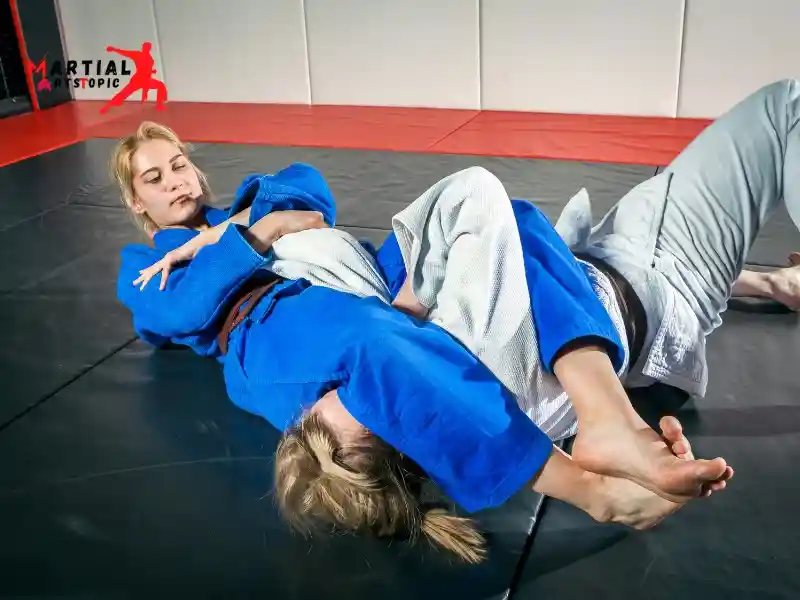
Judo is guided by two key principles: “Seiryoku Zenyo” (maximum efficiency) and “Jita Kyoei” (mutual welfare and benefit). These principles underscore the idea of using minimal effort to achieve the best results and fostering a sense of harmony and cooperation among practitioners.
In terms of techniques, Judo encompasses a wide range of throws, joint locks, and pins. Throws, known as “nage-waza,” are designed to off-balance and throw opponents to the ground. Joint locks, or “katame-waza,” focus on controlling an opponent through the manipulation of their joints. Additionally, pins, referred to as “osaekomi-waza,” involve immobilizing an opponent on the ground for a specified period.
Throughout its history, Judo has continued to develop, gaining widespread recognition as an Olympic sport and a valuable form of self-defense and physical fitness training.
Origins of Aikido
Aikido, meaning “the way of harmony with the spirit,” emerged in the early 20th century in Japan, under the guidance of Morihei Ueshiba, also known as O-Sensei. Ueshiba drew inspiration from his extensive training in traditional Japanese martial arts, including Jujutsu and Kenjutsu, as well as his spiritual and philosophical beliefs. Aikido was conceived as a means of self-defense that aimed to neutralize an opponent’s aggression without causing harm, promoting harmony, and non-violence.
Ueshiba’s personal journey deeply influenced the development of Aikido, including his profound spiritual experiences and his vision of martial arts as a path to inner peace and enlightenment. With its fluid and circular movements, Aikido embodies the principles of blending with and redirecting an opponent’s energy, transcending mere physical combat to encompass a holistic approach to harmonizing mind, body, and spirit.
Founder and Historical Background
Morihei Ueshiba found aikido, commonly known as O-Sensei, in the early 20th century. His extensive study of various martial arts influenced his vision for Aikido, including Daito-ryu Aiki-jujutsu, as well as his spiritual and philosophical beliefs. O-Sensei’s goal was to create an art that focused on harmony and non-violence, allowing practitioners to defend themselves while also protecting their attackers from injury.
Key Principles and Techniques
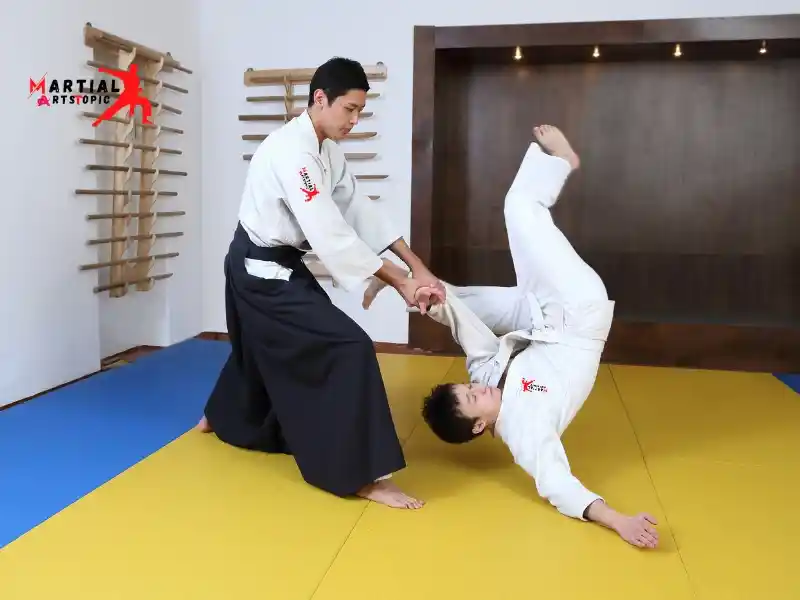
Several key principles, including blending with an attacker’s energy guide aikido, redirecting their force, and neutralizing aggression without causing harm. This is achieved through circular movements, joint locks, throws, and pins, emphasizing the use of an attacker’s momentum against them. Practitioners of Aikido also cultivate a deep awareness of their surroundings and an understanding of timing and distance, essential for effective self-defense techniques.
Aikido’s techniques are designed to subdue and neutralize aggression rather than to inflict harm, making it a highly effective martial art for self-defense and conflict resolution. Its emphasis on fluidity and adaptability makes Aikido a valuable practice for individuals of all ages and physical abilities.
Techniques and Training
In comparing Judo and Aikido, it’s important to understand the distinct techniques and training methods associated with each martial art. Judo focuses on throws, takedowns, and grappling techniques, emphasizing leverage and off-balancing opponents. On the other hand, Aikido incorporates joint locks, throws, and redirection of an opponent’s energy, promoting harmony and non-resistance. Both arts offer unique approaches to self-defense and personal development, catering to diverse preferences and physical abilities. Whether you’re drawn to the dynamic throws of Judo or the flowing movements of Aikido, exploring both disciplines can enrich your martial arts journey.
Understanding Judo Techniques
Judo is a dynamic martial art that focuses on using an opponent’s force against them. With a foundation in throws, grappling, and ground fighting, judo techniques require precision, timing, and control. The key to success lies in mastering the following fundamental techniques:
- Throws: Judo throws, or “nage-waza,” are designed to off-balance your opponent and execute a controlled throw. From the classic hip throw (o-goshi) to the powerful shoulder throw (seoi-nage), each technique demands proper footwork, body positioning, and fluid motion.
- Grappling: Known as “katame-waza,” judo grappling techniques encompass pins, joint locks, and strangles. Effective grappling relies on leverage, pressure, and the ability to transition seamlessly between techniques to gain the upper hand.
- Ground Fighting: When the fight goes to the ground, judo practitioners must be adept at controlling their opponent and seeking opportunities for submissions or escapes. Ground fighting techniques, or “ne-waza,” emphasize agility, awareness, and strategic positioning.
Training Tips for Judo Success
Now that we’ve delved into the core techniques of judo, let’s explore essential training tips to enhance your skills and elevate your performance:
- Focus on Fundamentals: Mastery begins with a solid foundation. Dedicate ample time to perfecting basic throws, grips, and movement patterns before advancing to more complex techniques. Regular practice of fundamental skills is the key to progress.
- Develop Core Strength: Judo demands physical strength and stability. Incorporate strength training exercises targeting the core, lower body, and upper body to improve your overall power and balance.
- Enhance Agility and Flexibility: Agility and flexibility are integral components of judo. Engage in agility drills, dynamic stretching, and mobility exercises to enhance your ability to swiftly maneuver and adapt to your opponent’s movements.
- Spar with Diverse Partners: Training with a variety of partners of different sizes, skill levels, and styles will broaden your experience and prepare you for the unpredictability of real-world combat situations.
- Mental Preparation: Judo is not solely a physical endeavor; it also requires mental fortitude. Practice visualization, meditation, and mindfulness techniques to sharpen your focus and cultivate a resilient mindset.
- Seek Expert Guidance: Regularly seek feedback and guidance from experienced instructors and judo practitioners. Constructive criticism and personalized coaching are invaluable for refining your technique and strategy.
Taking Your Judo Journey to New Heights

As you embark on your journey to primary judo, remember that progress is a continuous process. Embrace challenges, learn from setbacks, and celebrate victories, no matter how small. With unwavering dedication and a commitment to constant improvement, you can elevate your judo skills and experience the profound benefits of this dynamic martial art.
Whether you aspire to compete at the highest levels or simply seek personal growth and self-defense proficiency, judo offers a path to physical, mental, and spiritual development. Embrace the art of judo, and let its timeless principles guide you toward excellence on and off the mat.
Essential Aikido Techniques
- Irimi Nage (Entering Throw): This technique involves blending with an opponent’s attack and entering their space, ultimately executing a graceful throw that neutralizes the threat while maintaining control and balance.
- Kokyu Nage (Breath Throw): Aikido places a significant emphasis on the concept of breath and its connection to movement. Kokyu Nage involves using precise timing and blending with an opponent’s energy to execute a throw powered by the practitioner’s breath and centeredness.
- Koshi Nage (Hip Throw): This technique emphasizes the use of the hips and lower body to unbalance an opponent and execute a powerful throw, showcasing the efficiency and fluidity inherent in Aikido.
- Sankyo (Third Teaching): Sankyo focuses on wrist manipulation and joint locks, showcasing the intricate joint techniques that are a hallmark of Aikido practice.
- Kote Gaeshi (Wrist Twist): This technique involves a swift and precise wrist twist that redirects an opponent’s energy, leading to a controlled takedown while minimizing harm to both parties.
Effective Training Tips for Aikido Mastery
- Focus on Centeredness: Aikido places great importance on maintaining a strong and centered posture. By cultivating a deep awareness of your center and practicing techniques from this grounded state, you can enhance your stability and effectiveness in executing Aikido techniques.
- Partner Practice: Training with a partner is integral to Aikido development. By working with a variety of partners, you can adapt to different energies and learn to blend and redirect with fluidity and precision.
- Mindful Breathing: Incorporating mindful breathing into your Aikido practice can deepen your connection to your movements and enhance your ability to harmonize with an opponent’s energy, leading to more effective and graceful techniques.
- Consistent Repetition: Mastery in Aikido, as with any art form, requires dedicated and consistent practice. By committing to regular training and repetitive drilling of techniques, you can refine your muscle memory and internalize the principles of Aikido.
- Openness to Learning: Approach your Aikido practice with an open mind and a willingness to learn from both successes and challenges. Embrace the journey of continuous improvement and exploration within the art.
Benefits of Judo vs Aikido
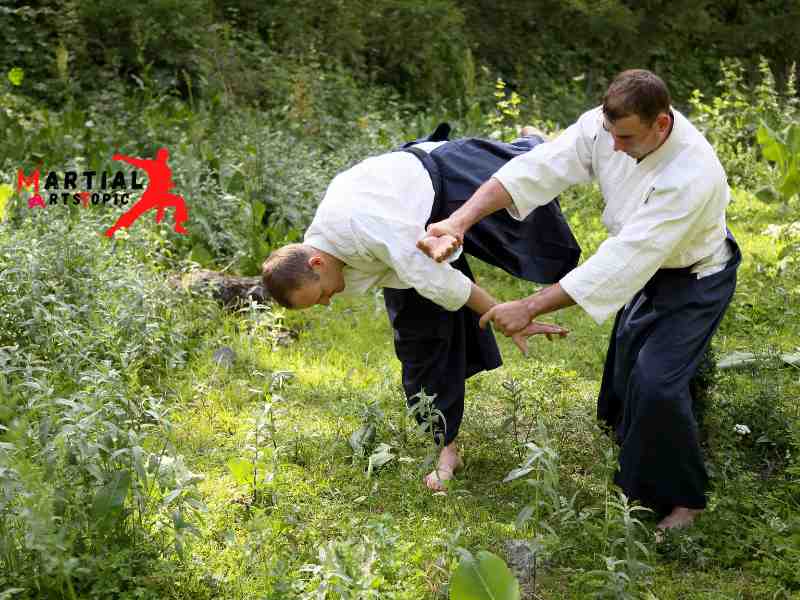
In the world of martial arts, Judo and Aikido stand out as two distinct disciplines, each with its own unique benefits and philosophy. In this blog post, we’ll delve into the differences between Judo and Aikido, and explore the specific advantages that practitioners of each art can enjoy. So, if you’re weighing your options and trying to decide between Judo and Aikido, this guide will help you gain a better understanding of what each discipline has to offer.Judo, often referred to as “the gentle way,” is a martial art that focuses on using an opponent’s energy against them. It emphasizes throws, joint locks, and pins to neutralize an attacker. On the other hand, Aikido, which can be translated as “the way of harmony,” is centered on blending with an opponent’s movements and redirecting their energy. It involves throws, joint locks, and immobilization techniques, with an emphasis on non-resistance and non-violence. Now, let’s inspect the specific benefits of each art.
Benefits of Judo
- Self-Defense: Judo equips practitioners with effective self-defense techniques that can be used in real-life situations. The focus on throws and grappling makes it a practical choice for self-defense scenarios.
- Physical Fitness: Training in Judo provides a full-body workout, enhancing strength, flexibility, and cardiovascular endurance. It also improves balance and coordination.
- Discipline and Focus: Practicing Judo instills discipline, mental toughness, and the ability to stay focused under pressure. These attributes can be beneficial in all areas of life.
- Stress Relief: Engaging in Judo can serve as a stress-relieving activity, allowing practitioners to release tension and clear their minds through physical exertion.
Benefits of Aikido
- Harmony and Non-Violence: Aikido promotes a mindset of non-aggression and peaceful resolution of conflicts. It teaches practitioners to redirect and neutralize attacks without causing harm to the opponent.
- Fluidity of Movement: Aikido techniques emphasize flowing movements and circular motions, which can improve agility, balance, and overall body coordination.
- Mental Clarity: The practice of Aikido encourages mental clarity, focus, and the ability to remain calm and composed in challenging situations.
- Connection with Others: Aikido fosters a sense of connection and empathy with others, as it requires practitioners to understand and respond to their partner’s energy and intentions.
Cross-Training and Integration
Judo vs Aikido are both martial arts with rich histories and unique philosophies. While they share some similarities, they also have distinct techniques and training methods. Many martial artists are interested in cross-training and integrating aspects of both Judo and Aikido into their practice.
Judo vs Aikido: Contrasting Philosophies
Judo, which translates to “gentle way,” is known for its emphasis on throws, takedowns, and ground grappling techniques. It was founded by Jigoro Kano in the late 19th century and has since become an Olympic sport, known for its dynamic and explosive techniques.
On the other hand, Aikido, meaning “the way of harmony of the spirit,” was developed by Morihei Ueshiba in the early 20th century. Aikido focuses on blending with an opponent’s movements and redirecting their energy, rather than meeting force with force. It incorporates joint locks, throws, and pins, with an emphasis on circular motions and fluidity.
Cross-Training and Integration
Cross-training in Judo and Aikido offers practitioners the opportunity to expand their skill set and gain a deeper understanding of martial arts principles. By integrating techniques from both disciplines, martial artists can enhance their adaptability and versatility in self-defense and combat scenarios.
Benefits of Cross-Training Judo and Aikido
- Diverse Skill Set: Judo’s emphasis on throws and groundwork complements Aikido’s focus on joint locks and redirection of energy, providing a more comprehensive range of techniques.
- Adaptability: Cross-training allows practitioners to develop the ability to switch between different martial arts strategies, adapting to various situations and opponents.
- Body Awareness: Aikido’s emphasis on blending and flowing movements can enhance a practitioner’s spatial awareness and proprioception, which can benefit Judo practitioners in close-quarters combat.
- Philosophical Alignment: Both Judo and Aikido emphasize respect, discipline, and non-aggression, making them philosophically compatible for practitioners seeking a holistic approach to martial arts.
Integration Techniques
Integrating Judo and Aikido involves understanding the underlying principles of each art and finding synergies between their techniques. For example, the circular motions and blending principles of Aikido can be integrated with Judo’s throws and takedowns to create seamless transitions and counter-attacks.
Training Tips for Integration
- Footwork and Balance: Focus on developing strong footwork and balance, as both Judo and Aikido require precise body movements and weight shifting.
- Timing and Distance: Practice understanding the optimal timing and distance for executing techniques from both disciplines, as they complement each other in close-quarters combat scenarios.
- Flow and Fluidity: Emphasize the smooth transition between techniques, utilizing Aikido’s flowing movements to complement the explosive power of Judo throws.
Judo vs Aikido: Choosing the Right Martial Art for You

Judo vs Aikido: Choosing the Right Martial Art for You. Are you considering taking up a martial art, but torn between Judo and Aikido? Both disciplines offer unique benefits and have their own distinct characteristics. In this comprehensive guide, we’ll delve into the differences between Judo and Aikido to help you make an informed decision and choose the martial art that best suits your goals and preferences.
Judo and Aikido both originated in Japan and share some common roots in traditional Japanese martial arts. However, they have developed into distinct practices with different focuses and techniques. Let’s explore the key differences and similarities between the two disciplines.
Judo: The Gentle Way
Judo, which translates to “the gentle way,” is a dynamic martial art that emphasizes throws, takedowns, and groundwork. Founded by Jigoro Kano in the late 19th century, Judo has become a popular sport and is also practiced for self-defense and physical fitness. It is known for its competitive aspect, with a strong emphasis on sparring and grappling techniques.
Key Characteristics of Judo
- Emphasis on throws and takedowns
- Utilizes leverage and balance to overcome opponents
- Competitive sport with a focus on sparring
- Groundwork and submission techniques are integral
Aikido: The Way of Harmony
Aikido, meaning “the way of harmony,” is a non-competitive martial art that focuses on redirecting an opponent’s energy and using their movements against them. Founded by Morihei Ueshiba, Aikido is often described as a peaceful practice that seeks to resolve conflicts without aggression. It emphasizes blending with an opponent’s energy and using circular movements to neutralize attacks.
Key Characteristics of Aikido
- Emphasis on circular movements and redirection of energy
- Non-competitive and non-aggressive approach to self-defense
- Techniques focus on joint locks, throws, and pins
- Spiritual and philosophical elements are integral to practice
Choosing the Right Martial Art for You
When deciding between Judo and Aikido, it’s essential to consider your personal goals and preferences. If you’re interested in a competitive sport with a focus on physical conditioning and sparring, Judo may be the right choice for you. On the other hand, if you’re drawn to a non-competitive practice that emphasizes harmony, self-improvement, and conflict resolution, Aikido could be the ideal fit.
Ultimately, both Judo and Aikido offer valuable benefits, including improved physical fitness, self-defense skills, and mental discipline. Whether you choose Judo or Aikido, the most important thing is to find a reputable dojo with experienced instructors who can guide you on your martial arts journey.
Conclusion
Judo and Aikido are fascinating martial arts with unique philosophies and techniques. While Judo focuses on throws, pins, and joint locks, Aikido emphasizes blending with an opponent’s energy and redirecting their movements. Each art offers valuable lessons in discipline, self-defense, and personal growth. Whether you’re drawn to the dynamic throws of Judo or the flowing, circular movements of Aikido, both arts have much to offer for those seeking to explore the world of martial arts. Ultimately, the choice between Judo and Aikido comes down to personal preferences and goals, but either path promises a rewarding journey of physical and mental development.
